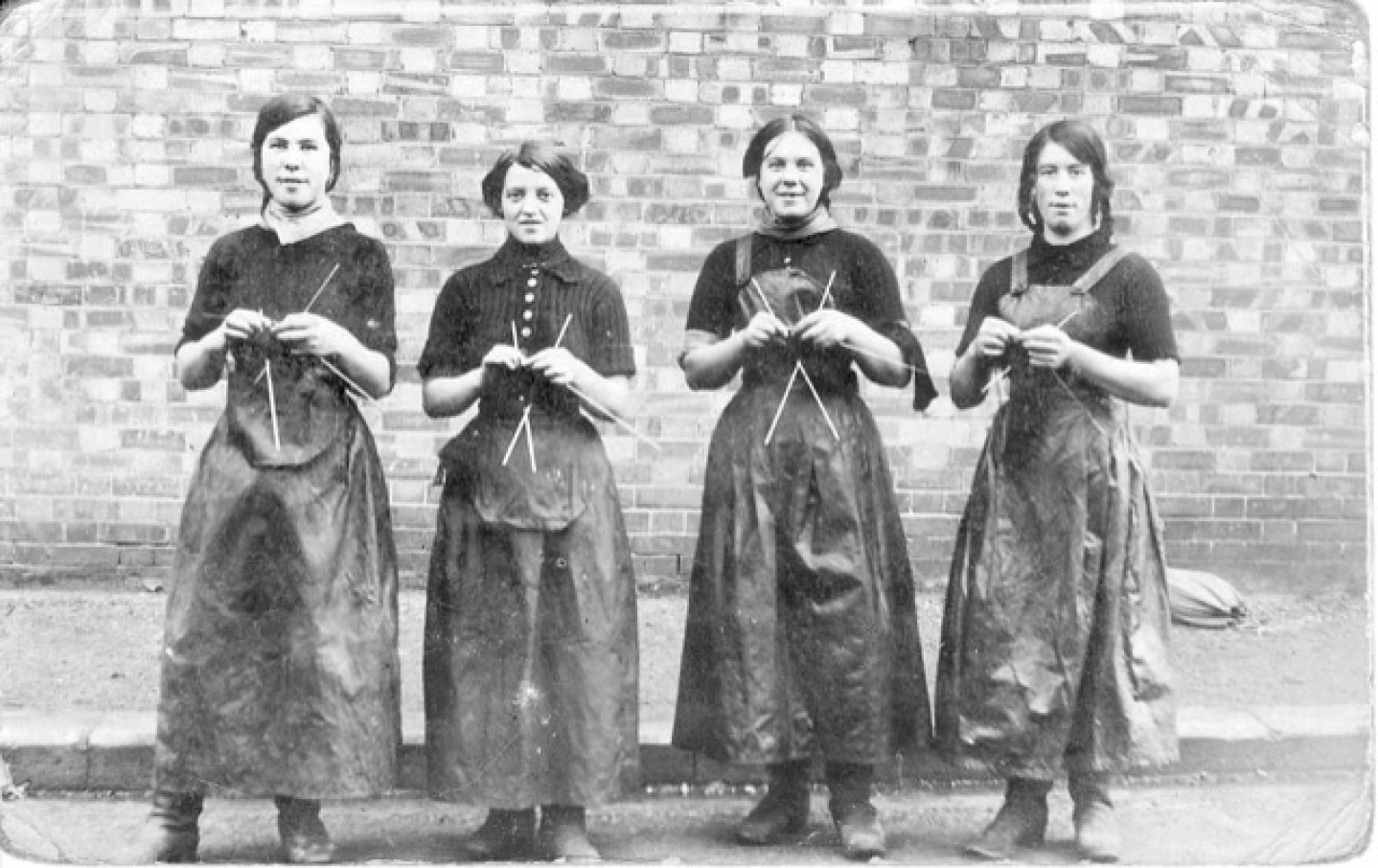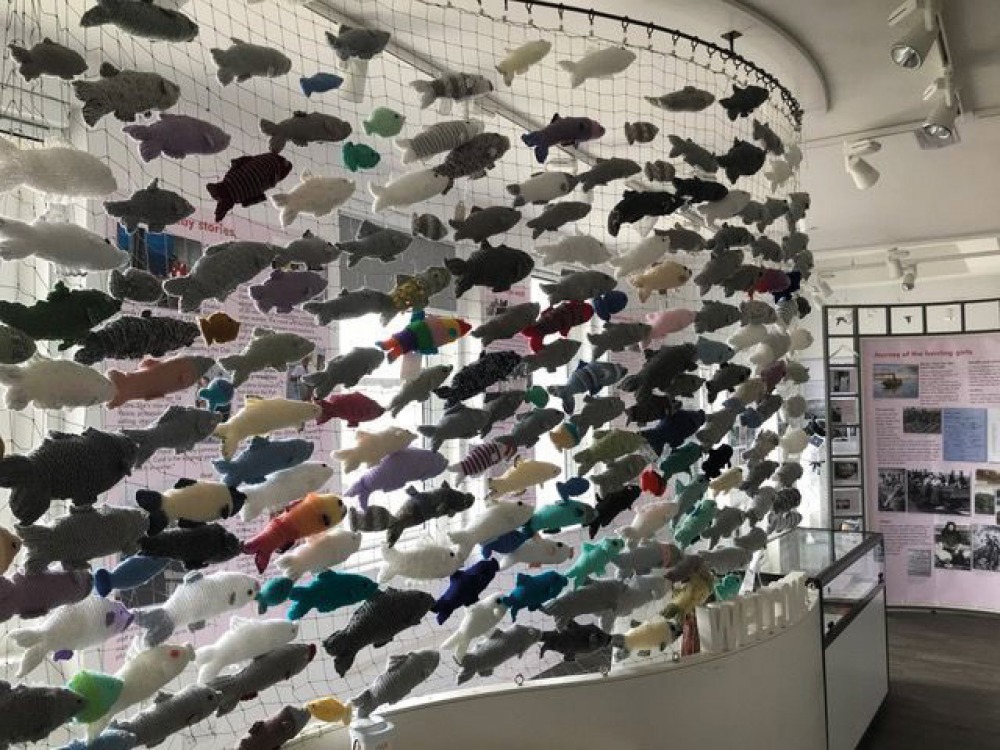Discover the Women Behind North Shields’ Fishing Heritage

We reel in the tales of the sea

Since The Old Low Light Heritage Centre opened six years ago in North Shields, it has focused on the working lives of fishermen who often risked (and in many cases lost) their lives at sea. But what about the women? That’s where this new exhibition comes in.
‘That’s Women’s Work’ is an exhibition highlighting the important role of women in the fishing and maritime industries over the past 150 years. It’s a showcase of stories about herring girls, local fishwives, smokehouse workers, and the modern-day role of women in maritime industries. There’s also a shoal of herring knitted by Old Low Light friends, and hand-knitted traditional fishermen’s ganseys on display.
‘We started by looking at the story of the herring girls who every year travelled from northern Scotland following the fishing fleet and stopping at ports, such as North Shields, to clean, salt and barrel the catch,’ says centre director Guy Moody. ‘However, we soon realised there was much more to share. Following appeals through local radio, newspapers and social media, we heard stories of women who supported these industries in many other ways, for example, working in the smokehouses on the fish quay, or going door to door, or travelling to local markets selling fish, usually from a creel on their back and a basket over their arm. We also heard stories of what it was like for the women who waited while the men were at sea, and how they coped with hardship and sometimes loss, while working, looking after their children, and keeping the house.’
We dive into some of the stories of these inspirational women from across the years.
The herring girls worked in teams of three, binding their fingers to protect against injuries. ‘It was hard, physical work,’ explains Guy. ‘They were out in the open in all weathers and, if catches were good, they worked late into the night. Experienced girls could gut the fish at a rate of one a second, grading the fish into baskets according to at least five sizes.’ But they’re best remembered for their knitting, which is celebrated throughout the exhibition. ‘In between landings, or if catches were poor, knitting was a favourite pastime, often making ganseys or socks for themselves or male family members.’
The girls usually arrived in North Shields in July or August, where they’d stay with local landladies and were looked after by the Fishermen’s Mission and local churches. Although well cared for and welcomed, soft furnishings were often removed and newspapers were used to cover the walls, as the smell of herring lingered. Through their local research, members of the heritage centre found stories of women who became herring girls – one being Doreen Mathieson. Doreen started working as a herring girl on the Fish Quay around 1940. With other local girls she travelled to different ports to clean and cure the catch. On one trip, while working at Fraserburgh, she met her husband Neil Mathieson. They had five children and moved to North Shields in the 1960s. She is now in her 90s and has been in to see the exhibition for herself.
The more research continued, the more stories came to light – including those of local fishwives. Some would stay locally, selling the fish door to door or via a stall, while others would head to Newcastle, and maybe travel by train to country markets in Northumberland. Cooking, housework and mending nets would be the jobs awaiting them when they got home.
‘Families have shared with us stories of what it was like for their mothers and grandmothers when the men were at sea, and how they coped with tragedy and loss, or days of worry and uncertainty when a boat went missing,’ Guy continues. ‘Our research tells us that these were very strong, independent women, who, as well as working, were usually bringing up a family and running the house when their husbands were away. We have been truly inspired by the strength and determination of all these women.’
Those women include Lizzie Alice Lisle, who married at 20 and moved from her home in Gosforth to live at the coast with her fisherman husband, John, who fished out of Cullercoats Bay in his coble. Lizzie’s creel, which is on display at the Old Low Light, was made by her husband John, who also made nets for the other fishermen. One of Lizzie’s daughters, Georgina, continued the family tradition and sold fish too – she worked until she was 89.
Lily Christie is another example of a determined local woman in the industry. She worked at Harry Horn’s kipper factory on the Fish Quay until she got married. Her husband Bertie worked on a steam trawler and, after he had a serious accident at work, Lily went back to work in the factory.
Reflecting on these stories, Guy considers how roles have changed in the fishing industry over the years. ‘Fishing was a man’s world and women generally did not go to sea,’ he says. ‘There were superstitions about women and the sea, which meant that women could not even go down to the quay to see their men off because this was considered unlucky. Some fishermen believed it was unlucky for a woman to come onto a boat. It was very unusual for a woman to be part of a fishing crew.
‘Fortunately, as our exhibition shows, times have changed and there are many more opportunities for women, and there are plenty more women at sea, working in fishing and offshore jobs. The ferry service between North and South Shields is managed by a woman. There are women volunteers on the lifeboat, and women either running or playing a key role in fresh fish and fish and chip shops on the quayside.’


In North Shields, Sheila Hirsch flies the flag for fisherwomen. Although now retired, she’s believed to have been the country’s first female trawler skipper. ‘It’s not something I’ve thought a lot about,’ Sheila says, when we ask what that means to her. ‘It’s always been the same for me. It was just a job and I never thought of myself as a woman when I went fishing – I always thought of myself as a trawlerman.’
Sheila always loved the sea and spent her summer holidays as a child with her grandparents in the west of Scotland. ‘My grandfather fished out of Oban,’ she continues. ‘I always wanted to go fishing with him, but at that time girls didn’t go to sea. To pacify me, he would take me on short journeys and said he wouldn’t take me fishing until I could tie a bowline. As a girl guide, I could tie knots and just before the summer holidays when I was almost 11, I managed to tie a bowline. My grandfather agreed to take me with him to sea but, before he got the chance, I sneaked out of their cottage, climbing through a skylight and hid under a net on his boat. The next morning one of the crew saw the net moving and thought there was a rat underneath. He lifted the net and he found me shuffling around underneath because I was feeling very seasick.’
Sheila was given a box to sit on and a bucket of herring to gut and clean. Her grandfather thought this (combined with her feeling seasick) would put her off – but Sheila proved him wrong. She worked for a while on a boat which took anglers out and got to know a lot of the fishermen – that’s when she decided she wanted to try fishing as a job. She later completed her skipper exams at South Shields Marine School.

Being accepted by men was difficult at the beginning, Sheila admits. ‘I felt I had to make myself indispensable, or prove I was better than them,’ she says. ‘I never dressed in a feminine way, always covering my hair with a hat or a bandana and wore a bib and brace and wellies. It was hard work physically and, at first, I had to take whatever fishing jobs I could get, sometimes just doing the odd day or two or three days at a time. Sometimes going out with a crew to tail the prawns. Sometimes, the men were worried about the lack of toilet facilities for a woman on a boat, but that never bothered me.’
Like a lot of fishermen and women, Sheila had a love-hate relationship with the sea, but she was always motivated to earn money for her family, and her grandfather remained her inspiration.
Who better to ask for advice for a woman looking to get into the fishing industry? ‘If they really want to go sea fishing, they should try it,’ Sheila says. ‘There are more women nowadays working on fishing boats and more training and opportunities for them. Fishing has changed so much over the years and is no longer the dirty and physical job that it once was. It is still hard work, but fishing boats have all the latest equipment, including electronic haulers. You don’t have to fillet the fish anymore – we had to gut everything. But to go to sea had to be something that a woman really wanted to do.’
The fishing community in the North East is tight-knit, and the Old Low Light Heritage Centre prides itself on bringing the community together. After all, it was brought to life because the local community shared a passion for preserving and promoting the heritage and history of North Shields and its fish quay. ‘The community is involved in all sorts of ways,’ centre director Guy tells us. ‘We rely on local volunteers who welcome visitors into the centre, help in the café, act as guides in the galleries, organise and deliver walks, talks and other events. Most of our exhibitions have been researched and presented by volunteers and locals who are regular visitors.
‘When we started researching this particular exhibition we were in lockdown, and as we were seeking stories and photographs about the women who had worked in fishing and maritime industries, we thought it would also be a good idea to involve people by asking them to knit fish to hang from a herring net. We made a pattern available and were delighted at the very positive response. We stopped counting when we reached 250 fish. Some said it gave them or other family members a purpose during lockdown, and it has brought visitors back to the centre after such a difficult period. Locals have also loaned us artefacts for the exhibition, and we filled a cabinet of curiosities with craft work from community groups and individuals. The entire exhibition was researched and designed by volunteers. The only costs were for printing display boards but these were covered by plant sales, again organised by volunteers. All of this local support is so important because we are a charity and every penny counts.’
Today, the fish quay is going through a transformation with the development of new housing, restaurants, cafés and bars, However, North Shields remains the biggest and busiest prawn port between Peterhead in the North and Brixham on the South coast, and at the height of the prawn fishing season (October to April) there are around 70 boats in North Shields.
The exhibition was initially due to come to a close at the end of the year, but having proved so popular (with many visitors returning with family and friends), it’s been extended.







